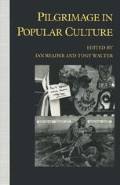Abstract
According to a popular Japanese saying the island of Shikoku, the fourth largest in the Japanese archipelago and the setting for Japan’s best-known pilgrimage route — which takes the pilgrim on a 900 mile circuit of 88 Buddhist temples around the island — comes alive in spring with the sound of pilgrims’ bells. At this time the courtyards of the Shikoku temples are thronged with crowds of white-robed pilgrims, bells hanging from their shirts or pilgrims’ staffs, chanting prayers in unison, lighting candles and incense, tossing coins noisily into offertory boxes, jostling each other to get the pilgrimage scrolls and books they carry stamped at the temple office, and buying religious amulets and souvenirs from the numerous stalls at the sites. Though spring has always been the main season for pilgrims — in pre-modern times this was the period in the agricultural cycle and in climatic terms when it was most convenient to travel — the changing economic structure of modem society and the development of high-class facilities and modes of transport for pilgrims have made the pilgrimage feasible at any time of year, and have transformed autumn into a second peak period. Nonetheless, the three months of March, April and May continue to account for around 45 per cent of all pilgrims (Satō 1990: 41–6).
Access this chapter
Tax calculation will be finalised at checkout
Purchases are for personal use only
Preview
Unable to display preview. Download preview PDF.
References
Gorai Shigeru, Kōya hijiri (Tokyo: Kadokawa Sensho, 1975).
Gorai Shigeru, Yugyō to junrei (Tokyo: Kadokawa Sensho, 1989).
Hakeda, Y.S., Kūkai: Major Works (New York: Columbia University Press, 1972).
Hinonishi Shinjō, ‘Kōya mōde- tokuni inseiki kara Kamakura jidai ni kakete’ Shūkyō kenkyū Vol. 57, No. 259, (1984) 265–6.
Hirahata Ryōyū. Shikoku hachijū hakkasho 2 vols, (Chōshi, Chiba: Manganji Kyōkabu, 1982).
Hoshino Eiki, ‘Shikoku henro to sangaku shinkō’, in Miyake Hitoshi (ed.), Daisan hhizuchi to Saikoku shugendō (Tokyo: Meicho Shuppan, 1979) 310–28.
Hoshino Eiki, ‘Shikoku henro ni okeru seichisei no tokushitsu’, in Sasaki Kōkan et al. (eds), Gendai shūkyō — 3 Seichi (Tokyo: Shunjūsha, 1980) 89–102.
Hoshino Eiki, Junrei: sei to zoku no genshōgaku (Tokyo: Kōdansha, 1981).
Imai Misako, Oyako henro labi nikki (Tokyo: Tōhō Shuppan, 1981).
Kanzaki Noritake, Kankō minzokugaku e no tabi (Tokyo: Kawade Shobō, 1990).
Kondō Yoshihiro, Shikoku henro kenkyū (Tokyo: Sanmii Shoten, 1982).
W. Lafleur, ‘Points of Departure: Comments on Religious Pilgrimage in Sri Lanka and Japan’, Journal of Asian Studies, Vol. 38/2 (1979) 271–81.
Maeda Takashi, Junrei no shakaigaku (Kyoto: Minerva Books, 1971).
Maki Mieko, Seishun henro (Private pilgrimage diary and journal in possession of the author, nd.)
Matsunaga, D. and A., Foundations of Japanese Buddhism, Vol. 1 (Los Angeles and Tokyo: Buddhist Books International, 1978).
Matsunaga Yūkei, ‘Kōbō Daishi no nyūjō shinkō ni tsuite’, in Hinonishi Shinjō (ed.), Kōbō Daishi shinkō (Tokyo: Yūzankaku, 1988) 171–80.
Miyata Noboru, Miroku shinkō no kenkyū (Tokyo: Miraisha, 1988 (first edition 1975)).
Murakami Mamoru, Shikoku henro reijōki (A commentary on and modern Japanese translation of Jakuhon’s Shikoku henro reijōki of 1689), (Tokyo: Kyōikusha Shinsho, 1987).
K. Noda, ‘A Pilgrimage in Shikoku’, in Intercultural Association of Kyoto (ed.), Essays on Japanology 1978–82 (Kyoto: Bunrikaku, 1983) 171–84.
I. Reader, ‘Back to the Future: Images of Nostalgia and Renewal in a Japanese Religious Context’, Japanese Journal of Religious Studies, Vol. 14/4 (1987a) 287–303.
I. Reader, ‘From Asceticism to the Package Tour: The Pilgrim’s Progress in Japan’, Religion, Vol. 17/2 (1987b) 133–48.
Satō Hisamitsu, ‘Shikoku henro no shakaigakuteki kōsatsu’, Mikkyōgaku No. 26 (1990) 29–47.
Shikoku Reijōkai Honbu (ed.), Sendatsu hikkei (Nishijō, Ehime: Shikoku Reijōkai Honbu Jimusho, 1983).
Shinjō Tsunezō, Shaji to kōtsū (Tokyo: Shibundō, 1960).
Shinjō Tsunezō, Shaji sankei no shakai keizaishiteki kenkyū (Tokyo: Hanawa Shobō, 1982).
Shinnen, Shikoku kudokuki, original (1689) text given in Iyoshi Dankai (ed.), Shikoku henro kishū (Matsuyama 1981: 209–32).
Shinno Toshikazu, ‘Shikoku henro no gyōja to sono shūkyō katsudō’, in Sakurai Tokutarō (ed.), Nikon shūkyō no fukugōteki kōzō (Tokyo: Kōbundō, 1978a) 83–108.
Shinno Toshikazu, ‘Kindai ni okeru tabi to shūkyō: ‘marebito’ no henshitsu’, in Shūkyō Shakaigaku, Kenkyūkai (ed.), Gendai shūkyō e no shikaku (Tokyo: Yūzankaku, 1978b) 83–95.
Shinno Toshikazu, Tabi no naka no shūkyō (Tokyo: NHK, 1980).
Takamure Itsue, Muslime junreiki (Tokyo: Asahi Shinbunsha, 1979).
Takamure Itsue, Ohenro (Tokyo: Chūō Kōronsha, 1987).
Takeda Akira, Junrei no minzoku (Tokyo: Iwasaki Bijitsusha, 1972).
Tanaka Yoshitaka, ‘Awa no reizan to shugendō’, in Miyake Hitoshi (ed.) Daisan Ishizuchi to Saikoku shugendō (Tokyo: Meicho Shuppan, 1979) 344—67.
Editor information
Editors and Affiliations
Copyright information
© 1993 Palgrave Macmillan, a division of Macmillan Publishers Limited
About this chapter
Cite this chapter
Reader, I. (1993). Dead to the World. In: Reader, I., Walter, T. (eds) Pilgrimage in Popular Culture. Palgrave Macmillan, London. https://doi.org/10.1007/978-1-349-12637-8_5
Download citation
DOI: https://doi.org/10.1007/978-1-349-12637-8_5
Publisher Name: Palgrave Macmillan, London
Print ISBN: 978-1-349-12639-2
Online ISBN: 978-1-349-12637-8
eBook Packages: Palgrave Social & Cultural Studies CollectionSocial Sciences (R0)

